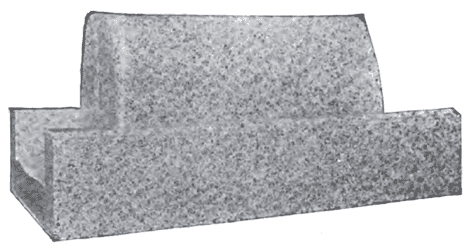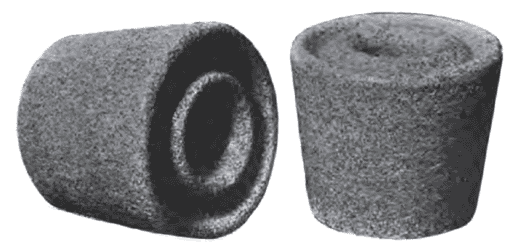[Trade Journal]
Publication: Street Railway Journal
New York, NY, United States
vol. 15, no. 5, p. 329-330, col. 2, 1
Reconstructed Granite
In the April issue of the STREET RAILWAY JOURNAL, some particulars were given of the third-rail railway at Coney Island. One of the important features of this line is the insulating blocks made of reconstructed granite, used between the rail sections. This material is so novel, and possess so many remarkable properties, that it is thought that a description of it would prove of interest.
 |
| Third-Rail Section Block |
"Reconstructed Granite" is exactly what its name implies, and consists of choice Maine granite, pulverized, moulded into form and fused together at a temperature of 3000 deg F. It differs from the natural stone, of which it is composed, in several very important respects, viz: (1) In being absolutely fireproof, as it can be heated red-hot and thrown into cold water without being in the slightest degree injured or affected thereby. (2.) It resists the action of every known solvent, acids and alkalies of all kinds, except hydro-fluoric acid, and is only superficially affected by that. (3.) It is absolutely frost-proof, having been tested in liquefied air at an estimated temperature of 350 deg. below zero not only without injury, but was as strong while frozen as before, and not at all brittle, in this respect differing from all other materials tested in this way. As it is a well-known fact that all natural rocks are disintegrated by extreme cold, and as 80 deg. to 90 deg. below zero is the coldest temperature known upon earth, the test is a severe one. (4.) Natural granite not only contains a considerable percentage of moisture, but has a constant tendency to absorb more when exposed to "dampness, whereas this material contains no moisture whatever, and being vitrified clear through (when prepared for electrical insulation), cannot absorb any. (5.) Its crushing strength, as shown by tests by the United States Government at the Watertown Arsenal, ranged as high as 14,560 lbs. per cubic inch, which is far above the average strength of the natural stone. Its tensile strength is from 480 to 500 lbs. per sq. inch.
 |
| Cup Insulators of Reconstructed Granite |
Its great strength, its uniformity throughout, its non-absorbent properties, and its susceptibility to being rapidly and economically moulded into all ordinary shapes, at a comparatively low cost, would seem to make it a valuable insulating material, especially for railway work, when it would be constantly exposed to the weather, and frequently buried under ground, for these reasons it is rapidly growing in favor upon electric railways, especially for third-rail insulation. Herewith are shown two forms of these insulating blocks made of this material, the first being the section insulator of the "Murphy system" tested at Manhattan Beach, and the other the cup insulators of what is known as the "Martin system." now being introduced upon the Brooklyn and other elevated railroads. There are also many other forms.
A recent test at Niagara Falls showed that it required 56,600 volts to penetrate about 1/2-in. of this material with a merely nominal absorption after soaking the fragments for many hours. Many other tests equally satisfactory have been made by eminent electricians.
Reconstructed granite is manufactured at Norristown, Pa., by the Reconstructed Granite Company, of New York. These works are very extensive, covering nearly 7 acres of ground, and have direct connection to all parts of the country by both the Pennsylvania Railroad and the Philadelphia & Reading (B. & O.) Railroad, both of which have sidings into the works.
